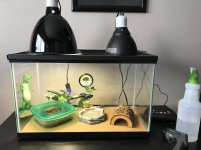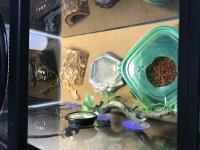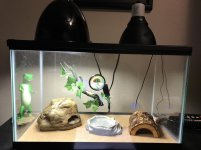jjainseattle
Member
My 3 or 4 year old leopard gecko just passed away...Very sad.
We left for a vacation and he was what we thought healthy. We returned and he was not doing so well. Turns out that he was not doing as well as we had thought and most likely had some long term lingering issues.
We did everything that we could to try to save Chili (Antibiotice, syringe feedings, saunas and whatever else the vet told us to do) but unfortunately he did not make it.
I am a complete novice and want to be a much better leopard gecko owner and give my new guy, Queso, the best life that I can.
I'm attaching photos of his set up - Its basic with a ceramic heat lamp on top and a heat pad below the log on the right side and a UVB light on the left side. I'm not certain what temps the right side should be and purchased a "Ipower Heat Mat Thermostat" to regulate the temperature if needed - Recommendations would be great. Both the ceramic light and the UVB lights are new purchases that I made as I tried to nurse Chili back to health.
We Fed Chili, our old guy crickets and mealworms - The crickets were stored in a cricket keeper and had some green gut loading stuff (smells like kiwi and is jelly consistency) in the keeper that was recommended by the Rescue Store where we buy Crickets.
For our new guy the Vet discouraged us from using the green stuff and told us to use T-Rex Calcium Plus to gut load the crickets - said to just put it into a bottle cap and the crickets will eat it and be more nutritious for our gecko.
The vet also said DO NOT feed mealworms as they are full of fat - kind of like a Krispy Kreme donut diet. She suggested Silk Worms, Phoenix worms, hornworms or black soldier fly larvae.
I want to be the best owner that I can be and could use any and all suggestions that you might have.
I want give Queso a long and happy life!
We left for a vacation and he was what we thought healthy. We returned and he was not doing so well. Turns out that he was not doing as well as we had thought and most likely had some long term lingering issues.
We did everything that we could to try to save Chili (Antibiotice, syringe feedings, saunas and whatever else the vet told us to do) but unfortunately he did not make it.
I am a complete novice and want to be a much better leopard gecko owner and give my new guy, Queso, the best life that I can.
I'm attaching photos of his set up - Its basic with a ceramic heat lamp on top and a heat pad below the log on the right side and a UVB light on the left side. I'm not certain what temps the right side should be and purchased a "Ipower Heat Mat Thermostat" to regulate the temperature if needed - Recommendations would be great. Both the ceramic light and the UVB lights are new purchases that I made as I tried to nurse Chili back to health.
We Fed Chili, our old guy crickets and mealworms - The crickets were stored in a cricket keeper and had some green gut loading stuff (smells like kiwi and is jelly consistency) in the keeper that was recommended by the Rescue Store where we buy Crickets.
For our new guy the Vet discouraged us from using the green stuff and told us to use T-Rex Calcium Plus to gut load the crickets - said to just put it into a bottle cap and the crickets will eat it and be more nutritious for our gecko.
The vet also said DO NOT feed mealworms as they are full of fat - kind of like a Krispy Kreme donut diet. She suggested Silk Worms, Phoenix worms, hornworms or black soldier fly larvae.
I want to be the best owner that I can be and could use any and all suggestions that you might have.
I want give Queso a long and happy life!








